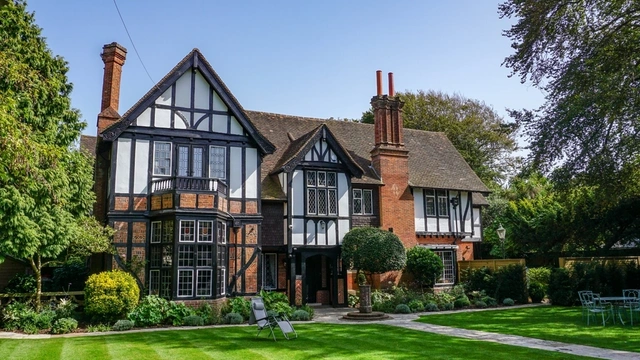We all love old houses! They have special features that make them unique and tell stories about families who lived there long ago.
But if you're thinking about buying an old house, especially one built during or before the Victorian era, you should know about some challenges that come with these beautiful homes.
Watch out for cracks and subsidence
Old houses sometimes have problems with their foundations. Years of soil settlement and moisture exposure can cause cracks in basement walls or uneven floors throughout the home. Without prompt attention, these problems typically worsen over time and could become increasingly expensive to repair.
- Victorian and Edwardian homes often have shallow foundations that can cause problems
- Houses built on clay soil can move when the ground gets wet or dry
- Trees near your house can drink up soil moisture and cause movement
- Subsidence happens when the ground under your house starts to sink
How can you tell if a house has subsidence?
Look for:
- Doors or windows that stick when you try to open them
- Cracks appearing in the walls
- The house looking tilted or uneven
If you see these warning signs, speaking with a building insurer could help and they may be able to point you in the direction of a specialist if needed. Sometimes cracks just mean the house has settled naturally, which isn't dangerous.
Dealing with damp and mould
Damp happens when moisture gets inside a building. Older houses often get damp because:
- They might not have modern damp-proofing materials
- The roof might not have proper waterproof barriers
- Empty houses tend to develop moisture problems faster
How can you tell if a house suffers from damp or mould issues?
Look for these signs of damp:
- Fuzzy mould growing on walls or ceilings
- Damaged or rotting wood, especially around the floor
- Dark patches on walls that get worse when it rains
- Rusty nails in woodwork
- Wallpaper that's peeling off
- Crumbling mortar between bricks outside
- A musty smell, like wet clothes that won't dry
You can fix damp problems, but some modern solutions don't work well in older houses. Get a damp survey before buying so you know what you're dealing with.
Dangerous materials to watch out for
Older houses sometimes contain materials we now know are harmful:
Asbestos - Found in houses built before 2000
- Can cause serious lung problems if disturbed
- Might be in ceiling tiles, pipe insulation, or around boilers
- Never try to remove it yourself - call a professional
Lead - Lead paint was sold until 1992
- Toxic especially for children and pregnant women
- Can cause many health problems including headaches and damage to organs
- Don't disturb lead paint - get expert help
These materials don’t need to stop you from buying an old house, but you should know about them and deal with the issues accordingly.
Electrical wiring concerns
Houses built before electricity became common weren't designed with wiring in mind:
- Very old wiring might not handle modern appliances safely
- If wiring is more than 25 years old, it should be checked
- Bad wiring can cause house fires
When buying an old house:
- Get a proper home survey that checks the electrical system
- Budget for rewiring if needed
- Try to get wiring work done before moving in, as it can be disruptive
Energy efficiency challenges
Old houses often cost more to heat:
- High ceilings look beautiful but can waste heat
- Single-glazed windows (even pretty ones) let warmth escape
- Old timber frames can be hard to insulate
- Drafty fireplaces lose heat up the chimney
These features mean:
Insurance costs for historic homes
You might pay more to insure an old house because:
- Repairs often need special materials to match the original building
- You might need expert craftspeople for certain jobs
- ‘Non-standard’ features like thatched roofs cost more to insure
- Listed buildings can require specialised materials and craftsmanship for repairs, making claims costlier for insurers.
Questions to ask when buying an old house
- When was the foundation last inspected? Foundation issues can be extremely expensive to fix, so knowing its condition is essential.
- Has the electrical system been updated? Old wiring or outdated electrical panels can pose safety hazards and might need replacement.
- What materials were used in the plumbing? Older homes might have lead pipes or dated materials that require modernisation.
- Are there any known issues with asbestos or lead paint? These common materials in older homes can create health concerns and lead to costly replacing.
- What renovations have previous owners completed? Understanding the home's renovation history helps you assess quality and identify potential unpermitted work.
Is it worth buying an old house and renovating?
If you can do a lot of the work yourself and do it well, renovating an old house can be a great choice. You'll save a lot of money when you don't have to hire professionals for everything. Plus, there's something really special about fixing up a place with your own hands.
But be honest with yourself about your skills. Can you put up plasterboard that looks smooth? Do you know how to safely update old electrical wiring? Are you patient enough to carefully restore original woodwork?
Mistakes in DIY projects can end up costing more to fix than if you'd hired a professional from the start. And some jobs, like electrical work or plumbing, can be dangerous if not done correctly. The best renovators know what they can handle themselves and when to call in experts.
If you have solid skills and know your limits, renovating an old house could be a rewarding adventure for you! If you’re less crafty, renovations could end up costly and outweigh any profit you’d get if you do sell.
To buy or not to buy…
Old houses in the UK are often beautiful treasures with amazing history! Just remember these possible challenges when making your offer. You might even be able to use this information to negotiate a better price with the seller.
Zubin is a personal finance writer with an extensive background in the finance sector, working across management and operational roles. He applies his experience in customer communication to his writing, with the aim of simplifying content to help people better understand their finances.
![Email icon]()
Become a money maestro!
Sign up for tips on how to improve your credit score, offers and deals to help you save money, exclusive competitions and exciting products!
Find this useful? Share it with others!









